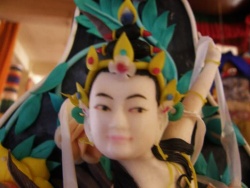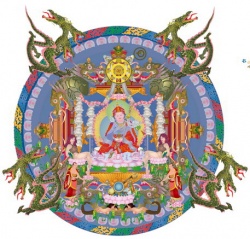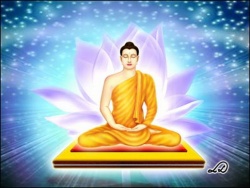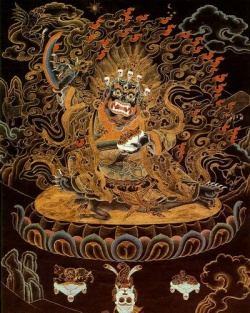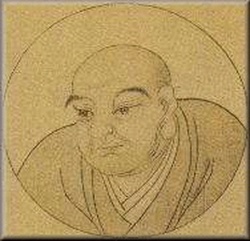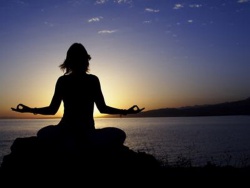The Use of Symbols and Rituals in Vajrayana / Mahayana Buddhism
Acharya Mahayogi Sridhar Rana Rinpoche
In the Digghanikaya Udumbarika Sihanada Sutta of the Pali Tripitaka, the Sasta (master) has told Nigrodha that it was not necessary to relinquish everything in his culture to become a Buddhist. He could continue to follow those cultural elements if they did not contradict the Samyag Drishti (correct view) view. For instance, it is not possible to continue animal sacrifice and still remain a Buddhist; however it is possible to perform the rites and rituals and symbols of the culture one grows up in if they do not contradict the basics of Buddhism.
Because through the centuries after the Buddha, millions of Indians, Bràhmins and otherwise became Buddhists, it is natural that the rites and rituals, the symbols and many such things were continued on as they did not contradict or distort the Samyag Drishti (correct view). These rites and symbols were taken from the general Indian socio-cultural milieu that existed then – be they Sramanic or Brahmanic or from some other local culture. As the Buddha himself has vouchsafed for such use of rituals and symbols, to see Hindu influence in all such rites, rituals and symbols is not only short sightedness, but specially if this criticism comes from another Buddhist denomination, it is a clear sign of idamsatyavinivesa. Idamsatyavinivesa is one of the Kayagrantha-s (bodily knots) that tie us to Samsara and it means holding on to a belief that “only the forms of symbols, rites and rituals, beliefs, ideas, that i believe, only my interpretations of the words of the Buddha, only my Master etc. only the form of Buddhism I follow, only the form of Vipasyana my teacher or my sub-sect teaches are the truth, all others are false.” In the Majjhima Nikaya, Canki Sutta, the Sasta has very clearly told Canki that to think –
Idameva saccam moghannam
i.e. “only this is the truth, all else is false” is not a thing that a learned wise man does.
So the teachings given by the Sasta to Canki and Nigrodha themselves sanction very clear use of any cultural elements like symbols and rites and rituals of any place and time as part of Buddhism if they do not contradict the Samyag Drishti (correct view).
A close study of such symbols and rites and rituals within Vajrayana / Mahayana shows that not only have such symbols and rites and rituals been taken from the background cultures be it Indian, Tibetan or Chinese etc., the use of such symbols etc. in Vajrayana / Mahayana is quite different from the use of these same or similar symbols and rites and rituals in other non-Buddhist systems. So not only were those symbols innocuous as far as Samyag Drishti (correct view) was concerned but also Vajrayana / Mahayana have remolded their meaning to make them closer to the Buddhist weltanschauung, to the Buddhist Samyag Drishti (correct view). This is a sign of healthy creativity rather than a sign of degeneration or muddling up or even influence of non-Buddhist systems.
Here, it is important to distinguish a very important point. Those who have tried to make Buddhism concord with Modernism have constantly harped on the point that the Buddha revolted against all rites and rituals. There are two things wrong with this view. Firstly, this is an attempt to fit the Buddha in a ‘modernist weltanschauung’ as if the Buddha’s view of the world was exactly like what came into existence in the cultures of the Western world after the 17th century due to scientific developments and the Industrial Revolution. Till about 1950, the whole of the Western culture was under the sway of Modernism. Modernism believed that only what was scientific or looked scientific was true, real, fact, un-superstitious; anything else that didn’t look scientific or similar to Physics and Chemistry was false, untrue, and superstitious. Needless to say, many Buddhist scholars and educated Buddhists of that time (especially those Buddhist monk scholars of the British colonial Ceylon) fell for this consensual hypnotic illusion and subscribed rather vociferously to this view. So anything within Buddhism that didn’t look scientific, was not analytically linear, didn’t fit the Cartesian Reductionist linear paradigm was thrown out the window and declared that the Buddha did not actually teach such a thing but rather was brought into Buddhism by latter-day decadent Buddhists.
Symbols and rites and rituals were among those most valuable psychotherapeutic elements which didn’t fit the Modernist paradigm. So they were declared as wholesale non-Buddhist; and they were actually things the Buddha himself actually taught against. However, after the Cognitive Revolution in the West in the 1950’s, Modernism has lost its stranglehold on Western cultural weltanschauung and is no longer considered as the whole and sole criteria to decide what is true and what is not. After the 1950’s, Post-Modernism began to fan out across the Western cultural horizon and Modernism gradually died out. Post-Modernism upholds the fact that the scientific view of life is only one mode of gauging reality and is by no means the whole and sole determinant of what is true or false; and there are alternate modes to experience / evaluate and interpret the world / reality etc. which are equally valid. Now, if we subscribe to these quaint ideas that the Buddha had the same view as the Modernists whose ideas began only after the 17th century and that too in the West; today we automatically make the Buddha outdated in this Post-Modernist world. It is also absurd to believe that the Buddha in the 6th century BC taught what the Modernists believed in the 17th century and refuted whatever these Modernists refuted or saw as false.
Secondly, in all the Sastra-s (even the Theravada Sutta-s) we don’t find the Buddha revolting against any rites and rituals or cultural elements – be they even Vedic. He only decried those parts of those rituals which were either meaningless or against the Samyag Drishti (correct view). He often re-interpreted those rituals giving them a new meaning or transformed those rituals to make them more meaningful, but he did not revolt against rites and rituals and symbols per se. In fact, in the Sutta Nipata, Magandiy Sutta, the Sasta says, “I do not say one attains purification by view, tradition, knowledge, virtue or ritual, nor is it attained without view, tradition, knowledge, virtue or ritual. It is by only taking these factors as a means and not grasping onto them as ends in themselves that one so attains and consequently does not crave for re-becoming” In this Sutta, the Sasta has clearly shown that he does not revolt against all rituals per se as useless mumbo jumbo but rather says very clearly that rituals can and should be used properly to attain purification etc. This certainly does not fit the ideas of those Modernist Buddhist scholars mentioned above. So it is clear that the Buddha has not taught against rites, rituals and symbols. In fact, he does even say very clearly, “I do not say one attains purification…without rituals etc…It is by only taking those factors (rituals etc.) as means….that one attains….” This Magandiya Sutta is certainly not very Modernist is it?
In the Anguttara Nikaya, the Sasta has mentioned in two different places (the 4th and the 5th Nipata) that offerings should be offered to those deities requiring offerings (Skt. bali grahaka devata). Now, this again is certainly a rite and ritual that the Sasta himself sanctioned. If this ritual was not so important, why would he say it at two different places or why would it be repeated at two different places in the same Nikaya? The Vajrayana / Mahayana still maintain this ritual to date. In the Majjhima Nikaya Saleyyaka Sutta, the Sasta says that it is Mithya Drishti (incorrect view) to believe that there are no Dana, Yajña and Havana. All three are rituals. The Sasta himself prescribed the worship of the Cetiya. In the Parinibbana Sutta, Diggha Nikaya, the Sasta himself has preached that the remains of the body of a Tathagata should be encased in a Caitya / Stupa and those who worship such Stupa-s with wreathes, perfumes, colors (sindura, avira etc.) with devout hearts will reap benefits and happiness for a long time. This is certainly very ritualistic and such types of offerings were offered in temples in India long time before the Buddha and they still continue even among non-Buddhists. In the same Parinibbana Sutta, the Buddha commands that his body be cremated like the body of a Cakravarti Emperor. He certainly did not say, “Do not perform any rituals at all because that is not a Buddhist thing to do” We find the Buddha himself sanctioning the worship of a tree (a transplantation from the Bodhi Tree in Bodhgaya) as a symbolic representation of the Tathagata. The Tathagata himself helped make the Stupa / Caitya / Cetiya for Sariputra’s remains saying such Stupa-s of arya-s should be worshipped. Any kind of worship is a ritual, and when rituals are accepted, symbols are accepted too.
As far as symbols go, there are no fixed meanings attached to any symbol according to the world famous psychologist C.J. Jung. That means, the same symbols can be given different meanings by Hindus, Buddhists, Jainas or Christians. Whether any symbol like ‘om’ etc. is Buddhist or Hindu or Jaina depends on what meaning you give to it, as they do not have any fixed meaning according to the world famous religious historian Mircea Eliade. So it is spurious to call Vajrayana / Mahayana influenced by Hinduism simply because there are some outward similarities in some symbols or rituals etc.
I would like to end this article with a quote by David Brazier, a psychotherapist and a Zen Buddhist from his book, ‘The Feeling Buddha’ – “When skillfully used, ritual is moving and transformative, reaffirming the connection between the particular individual experience and the larger drama in whole we all share. Ritual, properly employed is a therapeutic re-affirmation of the meaning and mystery of life.”
